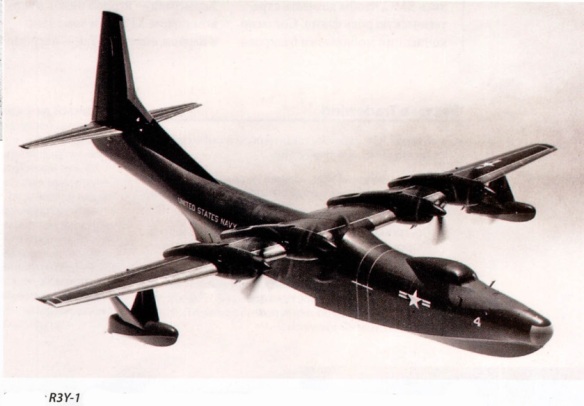One of six R3Y-2s configured as an amphibious assault transport. The nine R3Ys were the only type of turboprop-powered flying boats to ever reach operational service with the Navy.
The Convair R3Y Tradewind was an American 1950s turboprop-powered flying boat designed and built by Convair.
The only type of turboprop flying boat to enter service with the Navy, the design and development of the Convair Tradewind originated from a requirement issued by BuAer in 1945 calling for a long- range flying boat that would utilize turboprop propulsion and take advantage of recent advances in aerodynamic design. Antisubmarine warfare (ASW) was envisaged as the new aircraft’s primary role, with a secondary emphasis on transportation of troops and supplies. In May 1946, after reviewing competing designs, the Navy awarded Convair a contract to build two prototypes of its proposed model 117 under the designation XP5Y-1. At virtually the same time, Allison commenced a parallel program to develop the T40 powerplant, which, in order to reach the levels of power needed (i. e., 5,000-shp+), would entail mounting two T38 turboprop engines side- by- side and driving a propeller shaft through a common gearbox. The aerodynamic concept created for the XP5Y-1 was strikingly innovative: an exceptionally low- drag hull possessing a length/beam ratio of only 10:1 in combination with a high- aspect ratio wing employing a laminar-flow airfoil of very thin section. Fowler- type flaps occupying 60 percent of the wingspan would lower landing and takeoff speeds to the 100-mph range, depending on weight. Due to the thinness of the wings, stabilizing floats were placed outboard on streamlined fairings. The tail group consisted of a very tall fin and rudder and a horizontal stabilizer with slight dihedral.
Problems with the engine gearboxes delayed the first flight of the XP5Y-1 until April 18, 1950, by which time the Navy had already ordered the more conventional Martin P5M-1 into production to fulfill the patrol boat function. The following August, however, shortly after the XP5Y-1 had established a turboprop endurance record of eight hours six minutes, BuAer directed Convair to commence development of an unarmed transport version as the R3Y-1. Despite the loss of one of the XP5Y-1 prototypes in July 1953 in a non- fatal accident attributed to engine failure, work on the R3Y-1 continued without interruption. In addition to deletion of armament, major design changes involved modifying the nacelles for T-40A-10 engines, raising the aft hull to elevate the entire tailplane and removing dihedral from the horizontal stabilizer, plus adding twelve- foot cargo hatches on the port side. Other changes included pressurized accommodations for up to 103 fully equipped troops or 73 stretcher cases in an ambulance configuration. Full cargo payload was 48,000 lbs. The first R3Y-1 completed its maiden flight on February 24, 1954, and five of the six ordered had been delivered before the end of year. During operational testing, one of the R3Y-1s set a new transcontinental seaplane record by flying coast- to- coast at an average speed of 403-mph, a record which still stands today. The last R3Y-1 became the R3Y-2 assault transport when completed in December 1954 with a shorter, more bulbous nose that hinged upward to allow loading of troops, supplies, and vehicles from a beach, and five more R3Y-2s were delivered to the Navy during 1955.
In early 1956, once operational trials had been concluded, the five R3Y-1s and six R3Y-2s entered service with VR-2 at NAS Alameda, replacing the unit’s Martin JRM Mars. Two of the R3Y-2s were afterward fitted with probe and drogue in-flight refueling systems, and in September 1956, one of them set a record when it simultaneously refueled four Grumman F9F-8 aircraft. Operations, however, were plagued by serious problems with the propeller gearboxes, resulting in the loss of one aircraft in May 1957 and another in January 1958. All remaining R3Y-1s and R3Y-2s were grounded in April 1958, and after being stricken in early 1959, sold for scrap.
Variants
XP5Y-1
Prototype patrol flying boat, two built.
R3Y-1
Transport aircraft for the United States Navy with side loading door, 5 built.
R3Y-2
Assault transport aircraft for the USN with shorter nose incorporating an upward-opening loading door, later converted to four-point tankers for probe-and-drogue operations, six built.
Operators
* United States
United States Navy
Specifications (R3Y)
General characteristics
* Length: 139 ft 8 in (42.26 m)
* Wingspan: 145 ft 9 in (44.42 m)
* Height: 51 ft 5 in (15.68 m)
* Wing area: 2,102 ft² (195.3 m²)
* Empty weight: 71,824 lb (32,579 kg)
* Loaded weight: 145,500 lb (66,000 kg)
* Max takeoff weight: 165,000 lb (74,800 kg)
* Powerplant: 4 sets of 3-bladesx Allison T-40 turboprops, 8 engines in 4 pairs, each with 5,100 hp (3,800 kW) each
Performance
* Maximum speed: 337 kt (403 mph, 624 km/h)
* Range: 2,420 nm (2,785 mi, 4,482 km)
* Service ceiling 39,700 ft (12,100 m)
* Rate of climb: ft/min (m/s)
* Wing loading: 69.22 lb/ft² (338 kg/m²)
* Power/mass: 0.14 hp/lb (230 W/kg)
